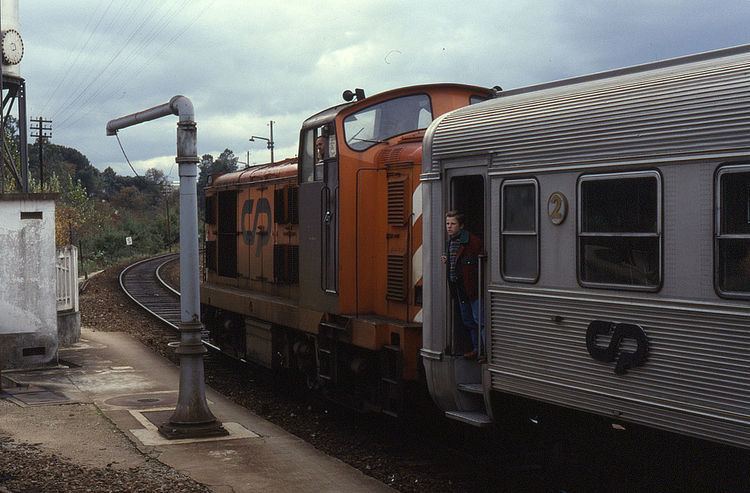Date 11 September 1985 | Rail line Linha da Beira Alta | |
 | ||
Operator Caminhos-de-Ferro Portugueses | ||
The Moimenta-Alcafache train crash ([mojˈmẽ.tɐ ˌaɫ.kɐˈfa.ʃɨ]) occurred on September 11, 1985, in Mangualde, Portugal, in the Portuguese Linha da Beira Alta. It killed about 150 people, making it the worst rail disaster in Portuguese history.
Contents
Context
The accident happened near the Moimenta-Alcafache station, in Moimenta de Maceira Dão parish, Mangualde municipality. This station is between the Nelas and Mangualde stations, in a single track zone.
The crash involved two passenger trains. One was operating an international service between Oporto and Paris, and was running 18 minutes behind schedule; the other one was on a regional service, heading for Coimbra. The regional train was composed of locomotive 1439, from the CP Class 1400 of Comboios de Portugal, and by 6 or 7 carriages, built by the Sorefame company; the Sud Express (international service) was made up of locomotive CP Class 1960 1961 and about 12 carriages. In total, about 460 passengers were aboard the two trains.
Crash
The regional service, which was stopping at all stations, arrived at Mangualde station, where it was supposed to stay until the international train had passed. However, notwithstanding the fact that the international service train had standing orders giving it the right of way, the regional continued on, estimating that the delay in the international's service would be enough for the regional to get to Nelas station, where the crossing could be effected. However, the international service was running with a shorter delay than expected; wrongly considering that the line was open to Mangualde station, it also moved on. After the departure, the Nelas stationmaster phoned Moimenta-Alcafache waystation to warn them about the international service departure, and was then informed of the oncoming regional train. Foreseeing that the trains would collide, he tried to warn the guardman on a level crossing between both stations by holding a banner or placing petards on the line; however, this action was not possible, as the train had already passed.
Around 18:37, the trains collided, while traveling approximately 100 km/h (62 mph) each. The shock destroyed both locomotives and some cars in both trains, and ignited several gasoline-fueled fires. Due to the fact that the materials used in the carriages were not fireproof, the fire spread quickly, producing great amounts of smoke.
Immediately after the crash, panic spread among the passengers, who were frantically trying to get out of the carriages. Many people, among them children, got out of the wreckage, having been helped by other passengers; others burned to death, or were asphyxiated by smoke and fumes.
Rescue and aftermath
The alert was given by military personnel of the Portuguese Guarda Nacional Republicana (National Republican Guard), who were operating on EN234, near the crash site. Although the rescue services arrived only a few minutes after the accident, the situation there was chaotic, with fires on the trains and forest around, many people hurt, and several passengers in panic.
It is estimated that, in this accident, some 150 people have perished, though the circumstances of the crash and the lack of control of the number of passengers in both services prevent an exact counting of the number of deadly victims. The official estimative points to 49 dead, from which only 14 were identified, with still 64 passengers officially missing.
Most of the remains that weren't identified were buried in a common trench near the crash site, where was also risen a monument in memory of the victims and the rescue teams.
Accident investigation
It was revealed that both stationmasters didn't communicate between them, neither to the control station in Coimbra, as regulamented, to tell them about the change of the crossing from Mangualde to Nelas; had this been done, the uncomformity of the circulation would have been noticed, and one of the compositions would have stayed on the station, so that the crossing could be made safely.
On the other hand, due to the lack of equipment, it was impossible to communicate with the involved trains; the only way to warn drivers was through signaling, and installing petards on the line, which, in this case, was revealed insufficient. Had this been done, trains could have been set in a halt in the stations. The communication system used at the time on that part of the route depended upon the use of phones to give information between stations and the control station.
In the wake of the disaster, more advanced safety, signaling and traffic control systems were installed, like the Speed Control, allowing a greater efficiency and security in rail operations, and making accidents like this nearly impossible of happening again; on the other hand, the introduction of ground-radio systems allowed a direct communication between drivers and control stations, and the use of materials that ease the propagation of flames was forbidden on trains.
